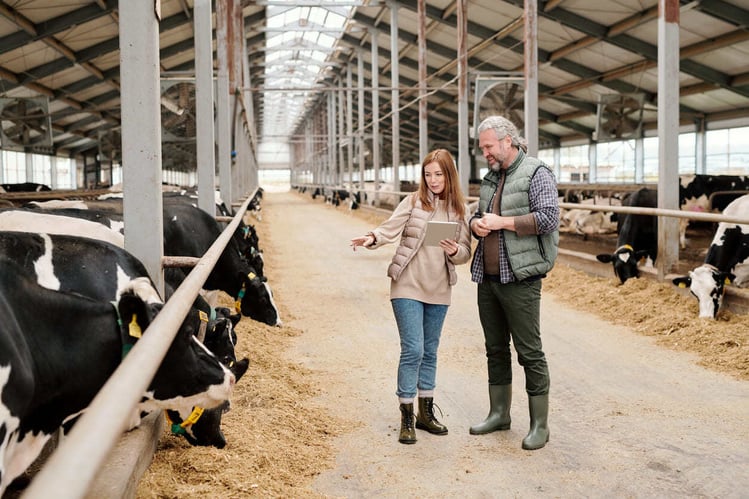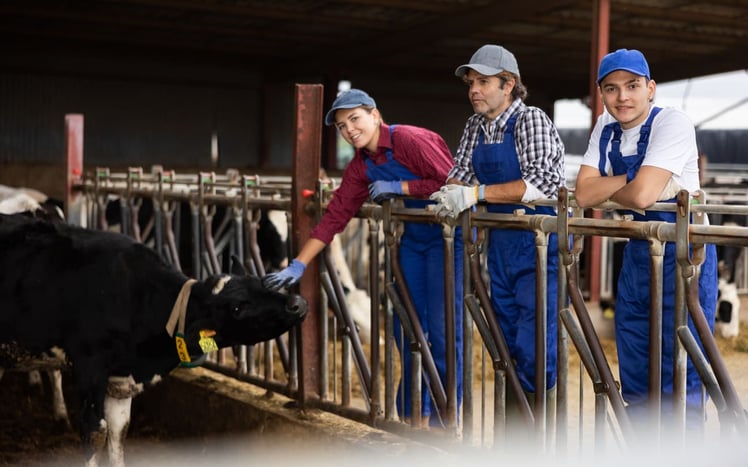In the context of livestock farming, animal health is a crucial factor to ensure productivity and sustainability. Traditionally, producers focus heavily on individual cow care, treating problems as they arise. However, the modern approach emphasizes the health of the herd as a whole, in order to prevent pathologies and improve production efficiency. Individual care is often reactive, treating illnesses only after they appear.
In contrast, herd health takes a preventative approach, focusing on management, nutrition and biosecurity practices that minimize the risk of health problems. This intervention not only improves animal welfare, but also increases productivity and reduces long-term veterinary costs.
Prefer to listen to this article? Click the play button below and enjoy our podcast!
Challenges in the Transition
The transition from individual care to the health of the herd as a whole faces several challenges. Communication with producers is be considered an important solution, but it can present difficulties, such as:
- Diversity of the public: farmers represent a heterogeneous group, with different levels of education, access to information and familiarity with new technologies.
- Resistance to change production and agriculture are rooted in practices and knowledge passed down from generation to generation, which can generate resistance to adopting new approaches.
- Lack of time and resources: producers' routine is generally exhausting, with little time available to dedicate themselves to new learning activities.
- Difficulties in accessing information: rural areas may have limited access to the internet and other sources of reliable information.

Effective Communication Strategies
To overcome such challenges and promote a shift in focus towards global herd health, it is necessary to implement effective communication strategies, such as:
- Personalized approach: adapting the language, examples and communication channels to the characteristics and needs of each target audience. Communication must be clear, using simple and concise language.
- Promoting dialogue and interaction: creating opportunities for producers to ask questions, exchange experiences and learn from each other.
- Education and training: one of the first steps will be to educate producers and workers about the herd health benefits as a whole. Organizing workshops, seminars and other courses is extremely effective. In these sessions, veterinarians and animal health experts can explain herd health concepts, present case studies, and offer hands-on practice.

- Local Partner Involvement: Collaborating with community leaders, veterinarians and other trusted figures is important to spread the message. Encourage participatory research: involve producers in participatory research that addresses their specific challenges and needs.
- Demonstrate practical benefits: Showing concrete results is a powerful persuasion tool. Conducting guided tours of farms that have already adopted herd health practices can allow farmers to see the benefits first-hand. Witnessing the reduction of disease, increased milk production and improved animal welfare can be very motivating.
- Technical support and consultancy: The transition to herd health can be complex and it is critical that producers feel they are not alone. Making consultants and technicians available for regular farm visits or offering support hotlines can help resolve issues quickly and reinforce producers' confidence in new practices.
- Use of information technologies: technology can be a valuable ally in communicating with farmers. Online platforms, mobile applications and social networks can be used to disseminate information, share educational videos and create communities of farmers to exchange experiences. This approach should be complemented by improving access to technologies in the farms and providing adequate tools to all the workers.

- Community engagement: Cultural change is most effective when it involves the community as a whole. Organizing community events, discussion groups, and partnerships with local cooperatives can create a mutually supportive environment. It should be noted that producers are more likely to adopt new practices when they see their colleagues doing the same.
- Personalized communication: each farmer has their own needs and challenges. Communication must be personalized, taking into account the specific context of each. Individual visits and personalized meetings can help adapt recommendations to local realities and build a trusting relationship.
- Financial Incentives: Financial incentives can accelerate the adoption of new practices. Government subsidies, affordable credit programs and partnerships with companies in the sector can reduce initial costs and make the transition more attractive. Informing and demonstrating how investments in herd health can lead to long-term savings is also important.
Conclusion
The transition from individual care to herd health is a significant change, but essential for the sustainability and productivity of livestock farming. Effective communication, which educates, motivates and supports producers, is fundamental to this transformation.
To promote the transition from an individual focus on animals to a focus on herd health, implementing well-thought-out communication strategies and using appropriate tools is essential. As it allows to reach farmers, motivate them to adopt new practices and contribute to a more sustainable agricultural industry with improved animal welfare.
About the author
Ana Vanessa Dias Sousa (Researcher FeedInov CoLAB)
With a degree in Veterinary Sciences from the University of Trás-os-Montes and Alto Douro, she worked for five years as a field veterinarian and in a pig and cattle feed factory. She worked in the pharmaceutical industry as a sales manager and technical support for pigs, cattle, rabbits and poultry in mainland Portugal and the Azores. She is currently at Feedinov Colab as a Researcher in the One Health Department.
Explore author’s articles


Leave your comments here